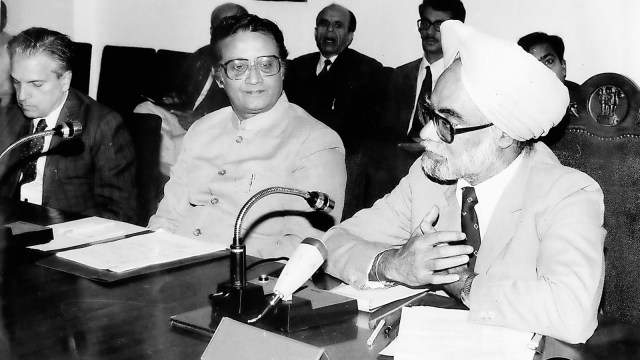Manmohanomics: Inflation focus to reforms in banking
With strong academic credentials, he carried out major legal reforms related to banking sector.
 Dr. Manmohan Singh, Deputy Chairman of Planning Commission inaugurating the 3rd Yojana Editors' conference in New Delhi on 19.2.1987. The Minister for Information and Broadcasting Ajit Panja is also seen in the picture. (Express archive)
Dr. Manmohan Singh, Deputy Chairman of Planning Commission inaugurating the 3rd Yojana Editors' conference in New Delhi on 19.2.1987. The Minister for Information and Broadcasting Ajit Panja is also seen in the picture. (Express archive)It was Indira Gandhi, Prime Minister of the country in 1982, who brought Manmohan Singh, then Member-secretary of the Planning Commission, to the Reserve Bank of India (RBI) to succeed the legendary IG Patel as the Governor. Singh who took the reins as the Governor on September 16, 1982 and held office till January 14, 1985, prepared the groundwork for strengthening the monetary policy actions and banking reforms got a boost.
Singh acknowledged in the book ‘Strictly Personal: Manmohan and Gursharan’, authored by his daughter Daman Singh, that he did have serious differences with the then Finance Minister Pranab Mukherjee when he was RBI Governor. Singh advised the government against granting approval to Bank of Credit and Commerce International (BCCI) — a foreign bank promoted a decade earlier by the Pakistan businessman Aga Hasan Abedi — to open a couple of branches in India. However, the government wanted the RBI to grant BCCI a licence, and directed it to approve the application. With the RBI led by Singh opposing it, the government took to the Cabinet a proposal to strip the RBI of its power to license foreign banks.
Singh protested and sent his resignation to Mukherjee and the Prime Minister. However, he was persuaded by the government to continue as the Governor. Singhand Mukherjee reportedly had differences of opinion on the hostile takeover plan of Escorts and DCM by UK-based industrialist Swaraj Paul.
Mukherjee wrote in his book ‘The Turbulent Years’ that the decision to move Singh to the Planning Commission from the RBI was taken by then Prime Minister Rajiv Gandhi. “I had absolutely no role in Dr. Manmohan Singh’s departure from the RBI. By December 1985, (then) Prime Minister Rajiv Gandhi was firmly in the saddle and I was out of the Cabinet and the party,” he wrote in the book.
Singh said the RBI Governor enjoys a position of respect in our system, but the Finance Ministry always “wants to downplay the status of the Governor”. “The RBI Governor is not superior to the Finance Minister in authority. And if the finance minister insists, I don’t see that the governor can really refuse unless he is willing to give up his job,” Singh’s daughter’s book quoted him as saying.
During Singh’s tenure, rural development got a further fillip and, most importantly, the foundations for modern day monetary policymaking that would be consistent with high growth and the expansion of financial markets were laid. The setting up of the Chakravarty Committee (1985) to reform the monetary and financial system was a reflection of this idea.
Singh’s tenure was also a period marked by double digit inflation as high as 11.87 per cent and high reserve requirements for the banking system. However, inflation came down to 5.56 per cent by 1985 following a moderation in monetary expansion.
Singh, with strong academic credentials and a doctorate from the University of Oxford, carried out comprehensive legal reforms related to the banking sector and a new chapter was introduced in the Reserve Bank of India Act and the Urban Banks Department was set up.
Statutory liquidity ratio (SLR) – the portion of bank deposits to be mandatorily invested in government securities – was as high 36 per cent. There was a request from the Government for a possible increase in SLR by 2.0 percentage points. Singh was firmly against the proposal and resisted the demand for SLR hike. In his letter dated January 20, 1984 to the Finance Secretary, the Governor postulated that the effect of an enhancement in SLR would mean that about Rs 1,550 crore would be diverted from non-food credit to the Government, resulting in lowering of the projected level of non-food credit of 14.8 per cent to 10.6 per cent, the RBI History says.
Unlike the Repo rate which is the main policy rate of the RBI now, during Singh’s tenure, main instruments were reserve ratios, changes in refinance limits and selective credit controls. SLR was raised to 36.0 per cent (July 28– September 1, 1984). Cash reserve ratio (CRR) – the portion of bank deposits to be compulsorily kept with the RBI — was raised to 8.0 per cent (May 28, 1983– July 30, 1983) and again to 8.5 per cent (August 27, 1983). There was an incremental CRR of 10.0 per cent (November 11, 1983). CRR increased to 9.0 per cent (February 4, 1984).
The necessity to reform the banking system was spelt out by Singh in his address at the founders’ day of the Bank of Maharashtra in Pune on September 16, 1984, where he identified new challenges and responsibilities that the Indian banking system was called upon to meet during the Seventh Five Year Plan. He hoped that this exercise would set in motion a process of thinking and debate about structural reforms, organisational improvements and procedural progression that were urgently needed to enable the banking system to perform successfully in the ensuing phase of India’s development, the RBI History says.
After a comparatively short tenure, he was shifted out on January 14, 1985, over a month after Rajiv Gandhi became the Prime Minister. After leaving the RBI, Singhwas appointed as Deputy Chairman of Planning Commission, a post he held till 1987 before becoming Secretary General of the South Commission, an independent economic policy think tank headquartered in Geneva from 1987 to November 1990.
- 01
- 02
- 03
- 04
- 05































